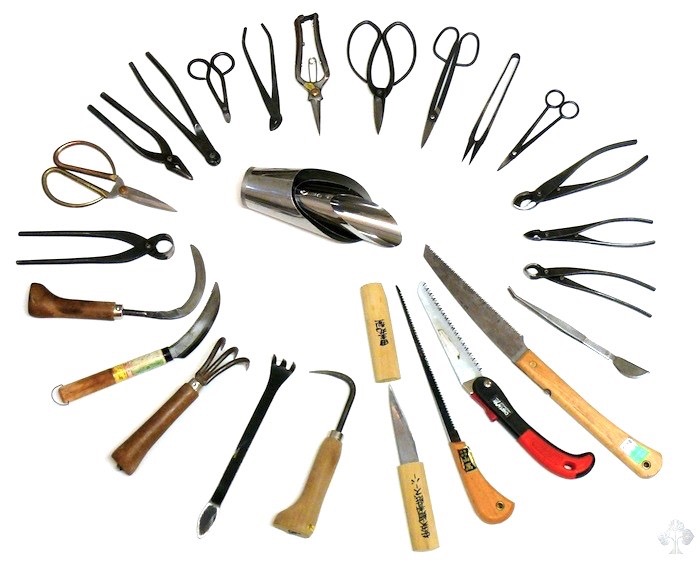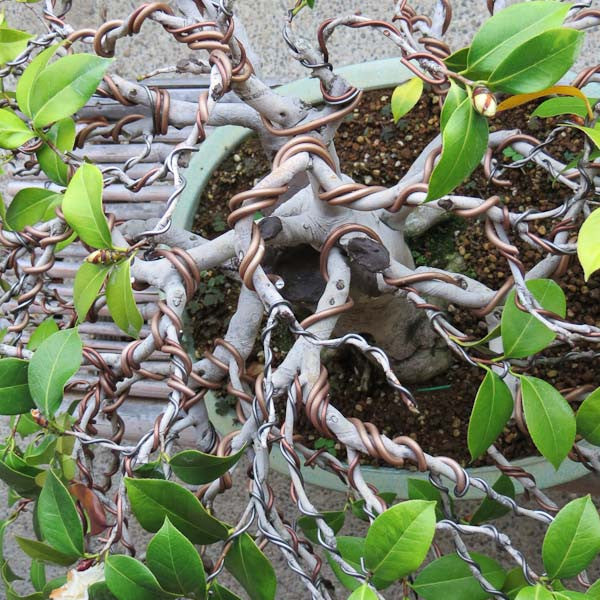Making a bonsai is no simple undertaking. You can begin figuring out how to do it by perusing the following not many articles and following the means introduced :
1- Cutting the branches

In order to control the shape and size of a Bonsai tree, the plants are to be cut. A first thing to mind of when starting to consider a Bonsai is cutting the branches and the sprouts.
A beginner should generally begin with customary trees, not a coniferous tree, with little leaves and rapidly creating pace. To rehearse your sentiment of shapes, the cornice must be first cut resembling a bow. The more prominent branches may exhibit hard to be cut. In time, you will get the experience to see wrong branches. Anyway, you should know three major norms when cutting branches :
- In all the branches that grow together from the same spot in the tree stem, in different directions, you have to cut one.
- The branches the cross over each other must be cut.
- The branches that are too thin and grow from the stem of the Bonsai must be cut, either.
These are required in order to grow yourself a Bonsai in natural size and shape.
2- Tools for cutting bonsai branches

- One narrow pair of scissors for this branches and sprouts.
- One pair of scissors for medium thick branches.
- One hand saw for very thick branches.
- One pair of pliers for buds, used for cleaning the cutting spots.
Cutting spots might be assaulted by microscopic organisms, growth or bugs. This is the reason you ought to secure the scar with an exceptional substance. The fluid amber lac, the acrylic one, might be utilized in a wet spot or when there is some sap spilling. More, there is an exceptional clay you can utilize, that is gone ahead to the dry cut spot. Both of these two techniques is useful for a bonsai.
The cutting time frame is in the winter or late-winter, during the rest time of the plants. Along these lines, the Bonsai tree doesn’t lose an excess of sap and they take the cutting much better. The meager branches and the sprouts might be cut throughout the entire year, since this isn’t terrible for the plant.
So as to have a decent shape by cutting the more youthful branches, you need to pick your tree cautiously. It is significant for a Bonsai that the tree has branches spread uniformly. On the off chance that they are spread, you can simple pick your primary branches, on which you will build up the Bonsai tree. The trees with hardly any branches or with branches that become lopsided are typically hard to change into a Bonsai tree.
So as to pick the branches to cut, you can test them by hand. Thusly, you can feel what branches must be evacuated. Remember that trees without such a large number of branches don’t have an excessive number of alternatives on the style. You must be extremely knowledgeable about developing Bonsai to get a great watching tree out of those. By first cutting the trees, you will animate the developing of the leaves and of the sprouts. This is significant for the last advancement of the tree.
More tips:
- The ramifications of a branch must be cut, if there are too many. Keep only 2, at most. The cut spots will be covered with grafting wax.
- A Bonsai tree that has been neglected for a long period of time grows very untidy and loses its “mature tree” looks. You can obtain a good looking Bonsai tree only by a first radical cut, which will leave the tree looking exactly as it should.
- In order for the cut spots to heal fast and for the tree to grow strong, the Bonsai trees must be placed, temporarily, in big pots. The older and stronger branches will be those that will later grow buds and make the tree look as it should.
3 – Cutting the buds of Bonsai

In the spring, when new sprouts bud out and blossom, you have to evacuate them physically, with some scissors or a tweezers. In the event that these will be left to develop, the state of the plant will be ruined. All the improvement of the Bonsai tree will occur at the top plant, however the lower branches will kick the bucket. The new buds and sprouts should be controlled, since they will truly pass over the entirety of your work in a while on the off chance that you don’t deal with your Bonsai tree.
The deciduous trees will be cut all the late spring. You should expel all the excess material and adjust the tree to your own ideal shape and size. A little Bonsai will be let to develop while a 20-25inches/60-80cm tree will be sliced a ton so as to stop the development.
the excess material and adjust the tree to your own ideal shape and size. A little Bonsai will be let to develop while a 20-25inches/60-80cm tree will be sliced a great deal so as to stop the development.
You should evacuate the buds and sprouts of conifers just in the spring, with some scissors and the tweezers. In the late spring, the sprouts that develop excessively and solid will likewise be evacuated.
5 – Cutting the leaves of bonsai

All together for a Bonsai tree to look great, the leaves of the tree should coordinate the size of the tree. A Bonsai tree 8inch/20cm measured will look peculiar with 4inch/10cm leaves. You could slice the leaves so as to lessen their size. Not all the deciduous trees can take this activity (you can discover every one of these information in the portrayal of each tree type).
Beginning from June until July, when the principal leaves have developed, they can be cut. In around a month, you will have new leaves, littler and significantly progressively many. In the event that the leaves will have longer tails, you should cut the outside of the leaves and let the tails on the branches. In the event that the leaves don’t have tails, you ought to tear them or cut them directly from the branch.
The leaves that become a lot throughout the late spring ought to be expelled if essential. More, you ought not prepare the dirt when the cutting of the leaves and you ought not water the plant a lot of either. The tree ought to be placed in a semi shadowed spot until the new leaves develop back once more. Recollect that cutting isn’t effortlessly taken by trees so you should just cut the pieces of solid and sound plants, particularly those that just endured branch shortenings.
6 – Wiring, trimming and arching of the Bonsai trees


So as to shape the storage compartment and parts of a Bonsai trees, the plant ought to be wired and cut. In the event that you plan to wire the trees and help them with little posts, you have to truly know and comprehend the wiring procedures.

Wiring (binds a tree with wires) is the most utilized strategy, particularly with conifers. The branches will be integrated up to the highest point of the tree. With deciduous trees, the shape might be obtained by utilizing external cutting and the wires will be utilized uniquely in contrast to one types of tree to another.
When molding a tree with a smooth bark, similar to the beech, elm trees, maple trees or linden trees, the wire ought not be permitted excessively long on the plant, on the grounds that the inserted wire leaves terrible imprints. On the opposite side, the things truly look distinctively when discussing junipers or pines. Their bark is significantly more unpleasant and the wiring scars disperse moderately quick. Obviously, the wire ought not implant in the bark. In the event that it ought to occur, you will have a winding like scar which won’t look so great.
Tip: You can use pegs to tie branches one to each other.

The wiring ought to be acted in the winter or the early springs, when you can continue with the cutting, either. The plant is still without leaves around then and you can undoubtedly arrive at any branch.
In the spring, there is a great deal of substance afflux, blooming and development, the branches go thicker. This is the primary motivation behind why you should look at the wire so it doesn’t implant in the bark. A quarter of a year later, the shape ought to be near what you want, so you can evacuate the wires. This activity ought not be messed with: you ought to unroll the wire cautiously, not cut it, since you can without much of a stretch cut off the branches.
Tip: the Bonsai trunks that cannot be wired should be attached to a bamboo stick.

Correct wiring requests exercise and proper handling. Before wiring the fragile branches of a Bonsai, you should exercise this in the garden or in the forests. You should use special Bonsai wire, aluminum covered with copper, in different sizes, from 0.02inch/0.7mm to 0.2inch/7mm, which you can buy in most Bonsai tree online stores.
The essential standard while picking the wires is this: the thickness of the wire ought to be at around 1/3 of the branch that is tied up. Along these lines, at a 0.3inch/1cm thick branch you should utilize 0.1inch/0.3cm wire. Try not to utilize an iron wire. It doesn’t twist excessively simple and it will rust off.
The first occasion when you shape a Bonsai tree from another plant you should wire all the branches, to the flimsy ones of them. No branch should cross with another. At long last, you should shape and trim branch by branch.
Wiring a Bonsai just has a decorative worth: it just changes the state of the tree. This makes what makes a Bonsai wonderful: the look. This is the reason you ought to shield the wired Bonsai trees from being seen: they are not what a Bonsai should like, yet.
The pegs ought to be utilized where the wire had fizzled: solid and thick branches and trunks. Various trunks might be fix to the focal trunk with pegs and corrected, if vital. This requires a mighty draw so you should check every now and then for the wire not to install and you should change the pegs once some time, moreover.
branches and trunks. Various trunks may be fix to the central trunk with pegs and revised, if essential. This requires an extraordinary power so you should check occasionally for the wire not to introduce and you should change the pegs once some time, as well.
Tip: in order to better tighten the pegs, you should use them with some leather underneath.
Bending the thick and strong branches using wire is problematic. They should be encased by wire. Deplorably, this strategy powers only a solitary advancement course for all the branches. This strategy is generally used when the branches grow high and they ought to be occupied to the ground.
Keep in mind: in order to suitably and definitively wiring a Bonsai requires time and exercise. This is the key clarification you need to encase the branches by wire in order to shape them.